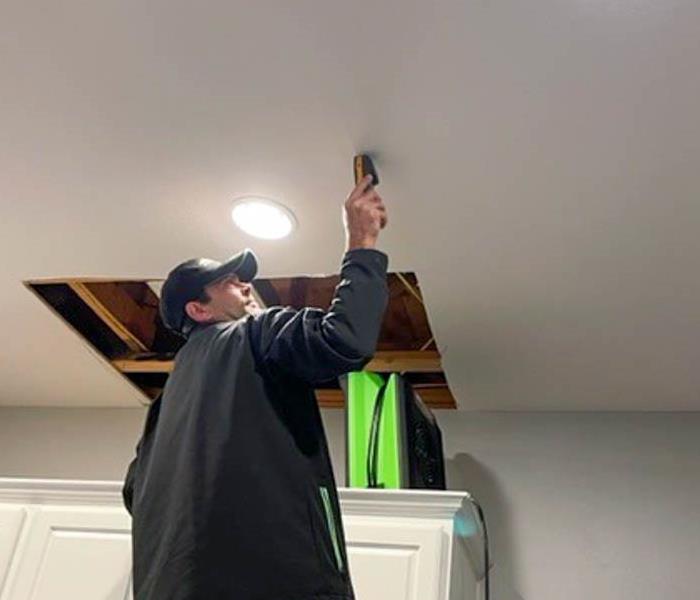The Most Common Types of Mold Found in Homes: Expert Insights from SERVPRO®
11/13/2024 (Permalink)
 In this blog, we’ll explore the most common types of mold found in homes, offering expert insights on how to identify and address these mold issues.
In this blog, we’ll explore the most common types of mold found in homes, offering expert insights on how to identify and address these mold issues.
Mold is a common issue that many homeowners face in Hutto, TX, especially in areas prone to moisture and humidity. While mold might seem like a minor nuisance, understanding the different types of mold that can grow in your home is essential for proper prevention and remediation. Each type of mold has unique characteristics, and knowing what you’re dealing with can help you address it effectively and protect your property.
In this blog, we’ll explore the most common types of mold found in homes, offering expert insights on how to identify and address these mold issues.
Mold in Homes: A Common Problem
Mold can develop anywhere there is moisture, warmth, and organic material. Whether it's from a leaking pipe, poor ventilation, or a damp basement, mold can quickly take hold. According to the Environmental Protection Agency (EPA), approximately 10% of U.S. households report mold problems at any given time. You can read more about mold prevention and management tips from the EPA.
Now, let’s take a closer look at the most common types of mold found in homes and what you need to know about each one.
1. Cladosporium
Characteristics:
Cladosporium is a common mold type that typically appears as black, green, or brown spots. It often grows on surfaces like wood, carpets, and fabrics, but can also be found on HVAC systems, especially if the filters are not maintained.
Where It’s Found:
You’ll commonly find Cladosporium in areas with poor ventilation or where moisture tends to collect, such as attics, basements, or closets.
Prevention Tip:
To prevent Cladosporium growth, ensure your home has proper ventilation and reduce humidity levels, particularly in closets and basements.
2. Aspergillus
Characteristics:
Aspergillus is another prevalent mold type that comes in a variety of colors, including white, green, and yellow. This mold can spread quickly under the right conditions, especially in areas with high humidity or water damage.
Where It’s Found:
Aspergillus commonly grows on organic materials like wood, paper products, and even food. It’s often found in damp walls, insulation, and under sinks where water leaks have occurred.
Prevention Tip:
Fixing leaks and ensuring proper drainage around the foundation of your home can help prevent the growth of Aspergillus in walls and other areas prone to water damage.
3. Stachybotrys (Black Mold)
Characteristics:
Stachybotrys, also known as black mold, is infamous for its dark green or black appearance. It grows in areas that are consistently damp and is often associated with severe water damage.
Where It’s Found:
This mold is often found in places like bathrooms, kitchens, and laundry rooms, where pipes can leak, and water may accumulate unnoticed.
Prevention Tip:
To prevent black mold, fix any persistent water leaks immediately and ensure these areas are well-ventilated to reduce moisture buildup.
4. Penicillium
Characteristics:
Penicillium is known for its blue or green color and powdery texture. It spreads quickly and can often be found on water-damaged materials, such as wallpaper, carpet, and insulation.
Where It’s Found:
Penicillium thrives in areas that have experienced water damage, such as basements after flooding or areas around leaky roofs and windows.
Prevention Tip:
After any water damage incident, ensure that affected areas are thoroughly dried within 24-48 hours to prevent mold growth, especially Penicillium.
5. Alternaria
Characteristics:
Alternaria is a fast-growing mold that appears in black or dark brown patches. It thrives in damp areas and is most commonly found outdoors but can easily enter the home through windows, doors, and HVAC systems.
Where It’s Found:
Alternaria is commonly found in bathrooms, showers, and around window frames, especially if condensation forms regularly.
Prevention Tip:
Reduce humidity in bathrooms by using exhaust fans and cleaning water-prone areas like shower curtains and tiles regularly.
How to Prevent Mold in Your Home
While these are some of the most common molds found in homes, the key to prevention is controlling moisture. Here are some expert tips to keep mold at bay:
- Fix Water Leaks Promptly: Any leaks from pipes, roofs, or windows should be addressed immediately to prevent moisture buildup.
- Improve Ventilation: Ensure that high-moisture areas, such as bathrooms, kitchens, and basements, are properly ventilated. Use fans or dehumidifiers as needed.
- Monitor Humidity Levels: Keep your home’s humidity level between 30% and 50%. A hygrometer can help you track indoor humidity.
- Dry Water-Damaged Areas Quickly: After a flood or significant water exposure, thoroughly dry affected areas within 24 to 48 hours to prevent mold growth.
- Regular Cleaning and Maintenance: Regularly clean areas prone to moisture, such as bathrooms, kitchens, and basements. Keep HVAC systems clean and functioning properly to prevent mold from spreading through the air.
Trust SERVPRO for Mold Remediation
Mold problems can escalate quickly, especially if left undetected or untreated. If you notice signs of mold growth in your home, it’s important to seek professional help. SERVPRO offers expert mold remediation services, ensuring that your home is thoroughly inspected, treated, and restored to a mold-free condition. With years of experience, our team is equipped with the latest technology to address all types of mold infestations effectively.
Understanding the most common types of mold found in homes can help you take preventive measures to protect your property. Whether it's the fast-spreading Penicillium or the notorious black mold (Stachybotrys), every mold type presents its challenges. The key is early detection, proper maintenance, and immediate action when signs of mold appear. If you need assistance with mold prevention or remediation, SERVPRO is Here to Help® provide expert support and ensure your home stays safe and mold-free.

 24/7 Emergency Service
24/7 Emergency Service